TL;DR
To decorate a brown living room with a large TV, anchor the space with a big area rug, add wall art and curtains for color, and balance the TV with a wider media console. For best results, follow simple rules of thumb like a rug that fits under the front legs of seating and curtains hung high and wide. This step-by-step plan shows how to decorate a brown living room with a large TV without replacing everything.
How to Decorate a Brown Living Room with a Large TV
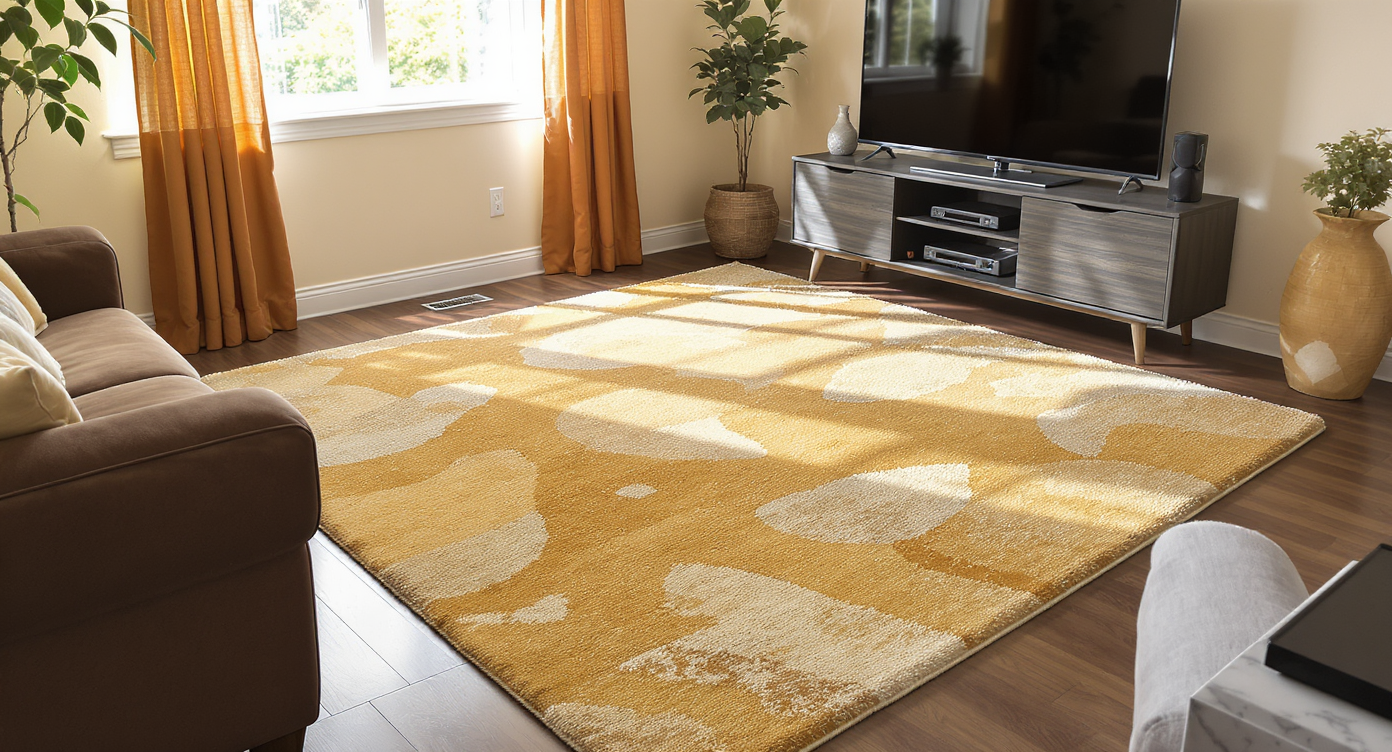
Use area rugs, color on walls and windows, and balanced furniture to warm up a brown living room space.
First-time homeowner? Use a large rug, layered color, and better TV balance to transform a brown living room into a warm, lively space. Living room decor often stumbles when everything skews neutral: brown floors, brown sofa, brown media unit. Add a giant screen, and suddenly the room feels more like a showroom than a home.
Here’s the thing: you don’t need to start from scratch. Designers often recommend three fast fixes that deliver outsized results in small living rooms and large ones alike: a generous area rug, color on the walls and windows, and art you genuinely love. If you also adjust the media console and coffee table, that brown-on-brown look softens into a layered, welcoming palette. Let’s walk through the steps.
Core Strategy: Living room decor that balances brown tones and a big TV
Start with scale: in most living rooms, an 8x10 or 9x12 area rug that allows at least the front legs of your sofa and chairs to sit on it will anchor the layout. A right-size rug reduces the dominance of brown floors and creates a natural zone for seating around a large TV.
- Choose a patterned rug with 2 to 3 colors you enjoy. Experts recommend pulling one accent tone into pillows and throws and repeating it at least three times.
- Balance the TV: a media console should be 6 to 12 inches wider than the TV to visually ground it and provide storage. If your screen is massive, consider low, long units joined together for the right width.
- Set viewing distance for comfort. For a 4K TV, a quick rule of thumb is 1.0 to 1.5 times the screen diagonal; for a 75-inch screen, that’s roughly 6.5 to 9.5 feet.
- Hang curtains high and wide. Mount rods 4 to 6 inches above the window frame (or near the ceiling) and extend them 8 to 12 inches beyond each side so panels don’t block light. Floor-skimming curtain lengths look tailored and soften hard edges.
- Create a color plan using the 60-30-10 rule. Aim for 60 percent base (walls/floor), 30 percent secondary (sofa, rug), 10 percent accent (pillows, art, decor). In a brown room, consider warm neutrals like oatmeal or camel for the secondary color and introduce a lively accent like moss, cobalt, rust, or saffron.
- Update the coffee table. If the current piece reads heavy or dated, paint it a matte black, soft ivory, or muted sage to contrast the floor. A round, light-toned table also helps break up linear flooring and sharp sofa angles.
- Float furniture when possible. Pull the sofa 6 to 12 inches off the wall and maintain clear paths of 30 to 36 inches. This small shift adds depth, especially when the back of the sofa is against windows.
- Layer lighting. Add a floor lamp near the sofa and a table lamp on the console to reduce screen glare and bring warmth at night.
- Finish with art and plants. Art should be about two-thirds the width of the sofa if it’s a single piece, or create a gallery grouping that spans that width. One large plant (around 4 to 5 feet tall) can balance the TV visually and bring life to the corner.
User insight: homeowners consistently report that the single biggest transformation comes from the rug plus curtains combo; everything else styles easier once those are right.
Anecdote
After living with blank walls for months, a new homeowner chose one oversized landscape and flanked the TV with two smaller pieces. The entire media wall felt intentional, and the screen looked like part of a gallery rather than the only show in town.
Common mistakes and how to avoid them
Scale and proportion drive comfort: aim for a rug that unifies seating, curtains hung high and wide, and a media console slightly wider than the screen.
- Buying a rug that’s too small. A 5x7 rarely works under a full-size sofa; bump up to at least 8x10 so front legs rest on the rug.
- Letting the TV dictate the room. The screen is important, but surrounding it with art, a wider console, and side lighting keeps it from feeling like a black hole.
- Hanging curtains too low or too narrow. Rods should sit several inches above the frame and extend beyond the window to increase perceived height and width.
- All-brown everything. Mix textures and tones: woven baskets, linen panels, matte black metal, and a patterned rug to break up sameness.
- Shoving furniture to the walls. Floating pieces slightly creates air and helps with cable management behind the console.
Pro tips and expert insights
Small, repeatable moves compound: repeat each accent color at least three times, hide TV cords, and use taller elements to balance the screen.
- Art sizing and placement: when hanging above a sofa, target 2/3 the sofa width and place the bottom edge about 8 to 10 inches above the back cushion. For gallery walls, keep 2 to 3 inches between frames.
- Painted table best practice: scuff-sand with 220 grit, apply a bonding primer, then two thin coats of enamel or durable cabinet paint; let it cure for 7 days before heavy use.
- Window textile savvy: for fullness, choose curtain panels totaling 2 to 2.5 times the window width; lined linen offers softness without glare.
- Layout guardrails: keep 16 to 18 inches between sofa and coffee table; maintain 30 to 36 inches for main walkways.
- Style the console: stack books, add a small lamp, and one sculptural object; leave 20 to 30 percent of the surface empty for visual rest.
- Use visualization tools: test layouts and color accents with a design AI such as ReimagineHome before you buy.
Suggested image caption: Large patterned area rug anchoring a brown living room; curtains hung high and wide; round light coffee table balancing a big TV.
Suggested image alt text: Brown living room with oversized TV balanced by a wider media console, 9x12 rug, layered pillows, plants, and wall art.
Anecdotes and real stories from lived-in homes
Real rooms teach fast: a larger rug, higher curtains, and a wider console can make a space feel curated rather than cobbled together.
- A giant-TV fix. One homeowner with a 75-inch screen swapped a narrow cabinet for a 90-inch low console and added a 9x12 rug. The TV stopped feeling like a billboard, and the console provided closed storage for cables and game controllers.
- The coffee table glow-up. A dated orange table was lightly sanded, primed, and painted soft ivory. Paired with two patterned pillows and a warm throw that echoed the rug, the once-orange centerpiece disappeared into a calm, cohesive story.
- Float to breathe. A sofa pushed against a window felt awkward and flat. Pulling it 8 inches forward, adding a tall plant to one side and a floor lamp on the other, suddenly gave the windows a frame and the seating area some depth.
- Color unlocked by art. After months of beige, a couple chose a large abstract with charcoal, teal, and clay. They echoed teal in curtains and clay in a ceramic lamp. The room finally had rhythm, and even the brown floors read rich rather than heavy.
Visualization Scenario
Picture this: a patterned 9x12 rug rolls out, the sofa shifts a few inches off the window, and full-length oatmeal drapes hang high and wide. A low, 90-inch media console stretches confidently beneath the TV. A round, light-wood coffee table sits 17 inches away from the sofa. On the wall, a bold abstract pulls teal, clay, and ivory from the rug. A tall plant lifts the corner, a floor lamp pools warm light, and suddenly the brown feels intentional—rich, grounded, and comfortably yours.
FAQ: quick answers to living room layout and styling
- How big should my area rug be in a living room?
A living room area rug should be large enough for at least the front legs of all seating to sit on it; 8x10 or 9x12 suits most layouts. Larger rooms often benefit from a 10x14 to fully anchor a sectional sofa. - What color should I paint an orange coffee table?
Neutral, high-contrast colors like matte black, soft ivory, or muted sage work well in brown living rooms. Sand, bond-prime, and use durable enamel so the finish holds up. - How high should I hang curtains in a living room?
Hang curtains 4 to 6 inches above the window frame or to the ceiling and extend rods 8 to 12 inches beyond each side. Panels should just kiss the floor for a tailored look. - How wide should a TV stand be compared to my TV?
Experts recommend a media console 6 to 12 inches wider than the TV to visually balance the screen and provide storage. Keep seating distance at roughly 1.0 to 1.5 times the screen diagonal for 4K. - How big should wall art be above a sofa?
Choose art that’s about two-thirds the width of the sofa and hang it 8 to 10 inches above the back cushion. For gallery walls, keep spacing consistent at 2 to 3 inches.
Bring it all together
Decorating a brown living room with a large TV is less about replacing everything and more about anchoring, balancing, and layering. Start with a properly sized area rug, hang curtains high and wide, widen the console, and repeat your accent colors with intention. From there, the space invites you in. Want to test a few looks before lifting a hammer? Try visual mock-ups with ReimagineHome and save yourself guesswork.
.svg)

.svg)
.jpg)
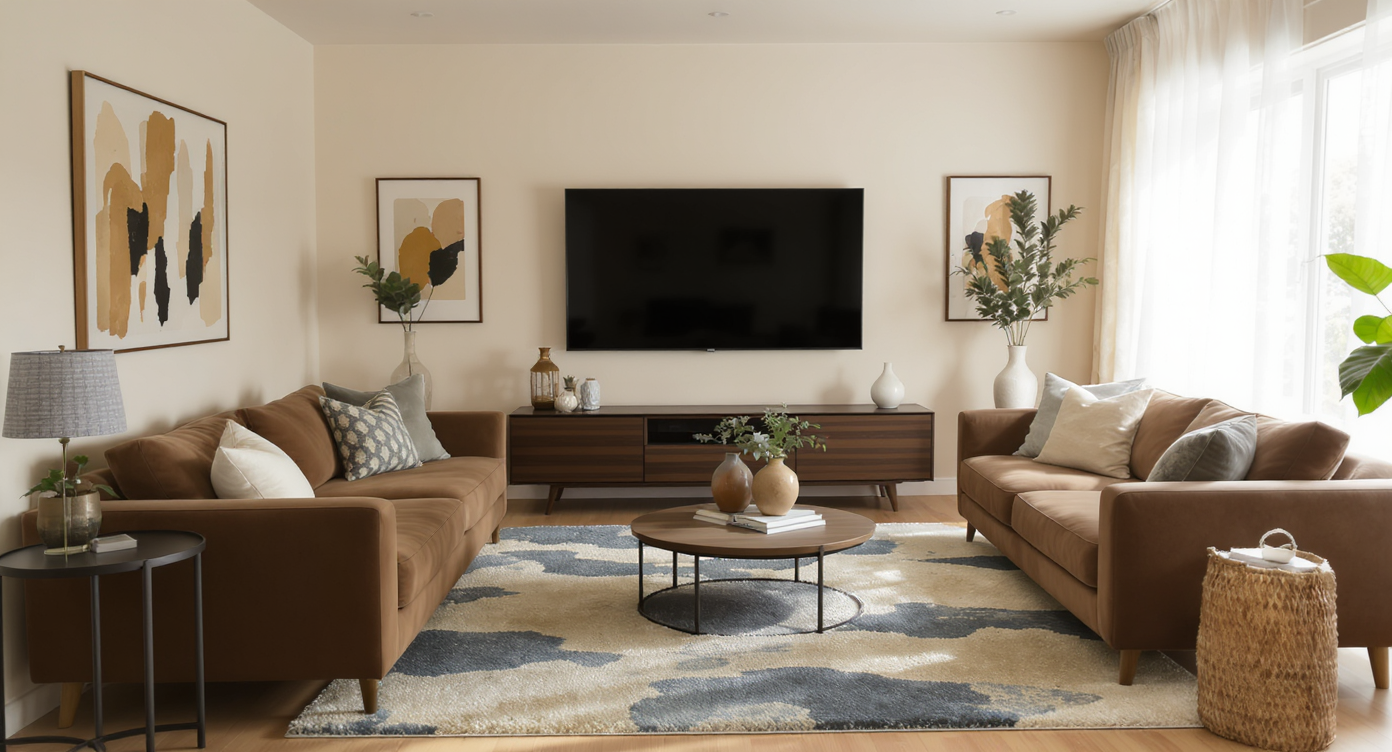
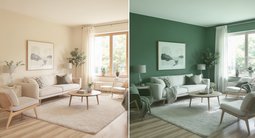
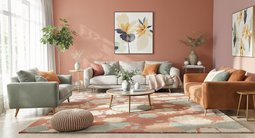


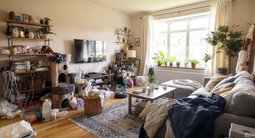
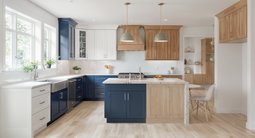
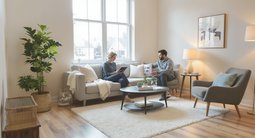
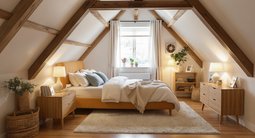
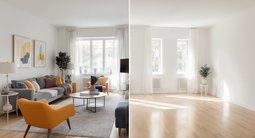


.png)